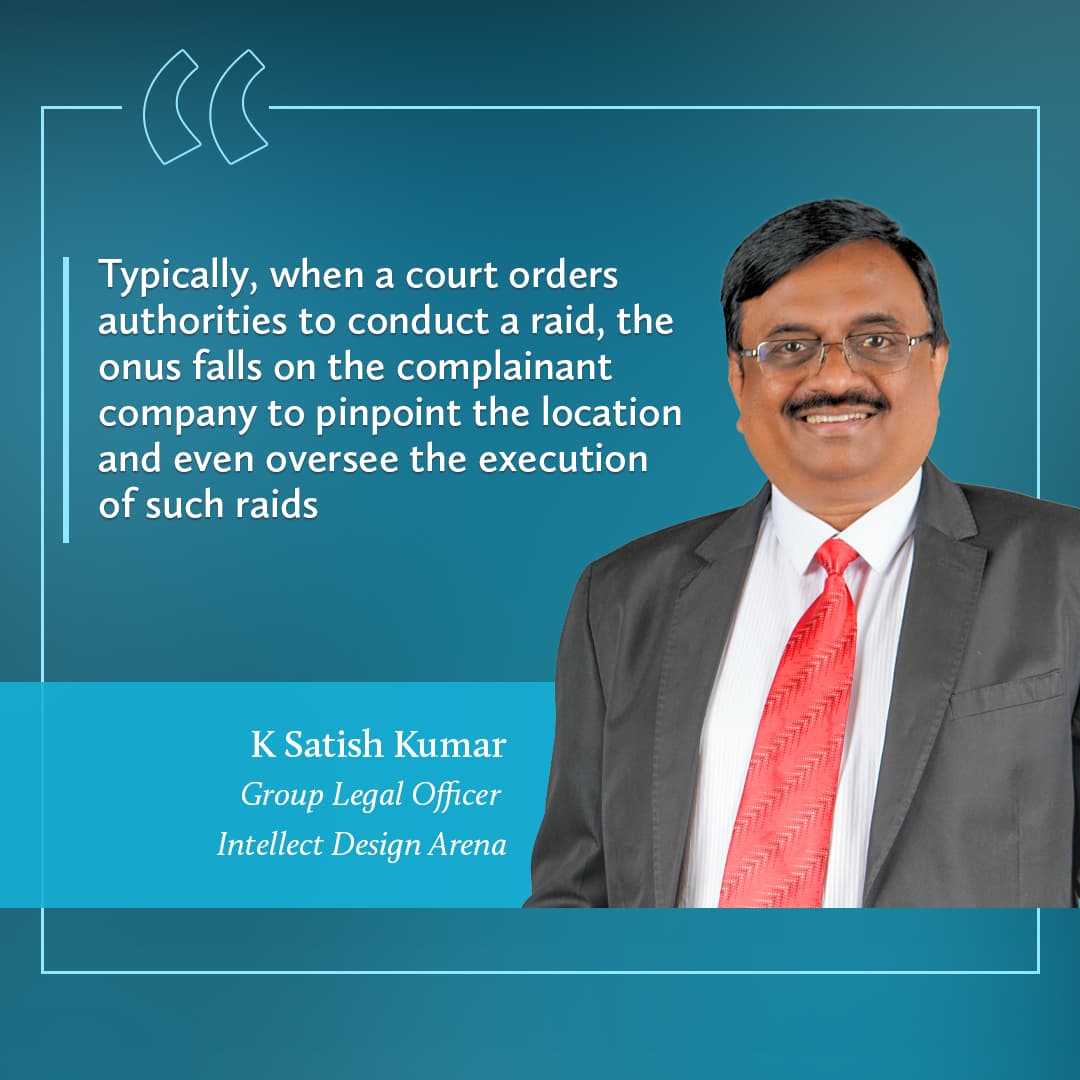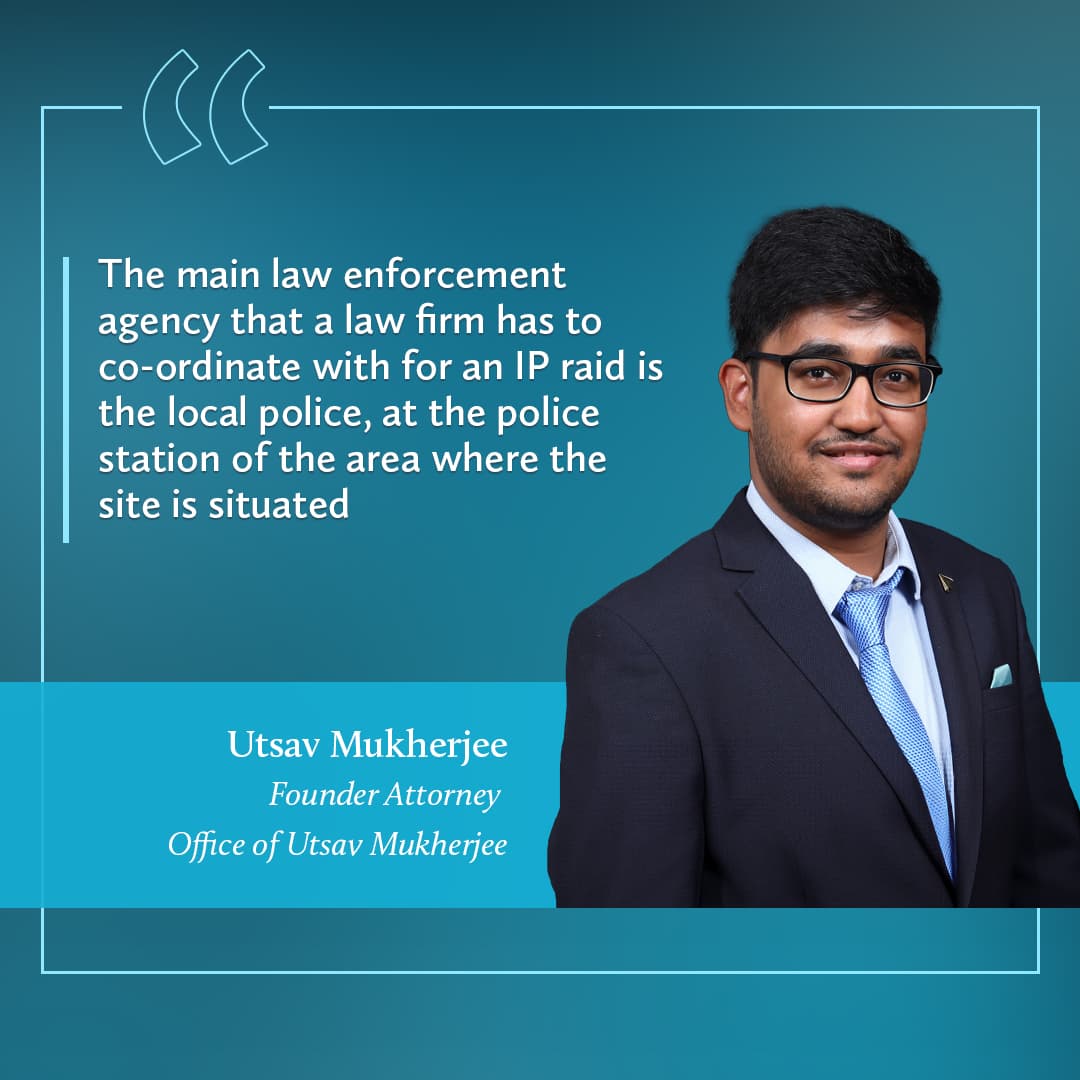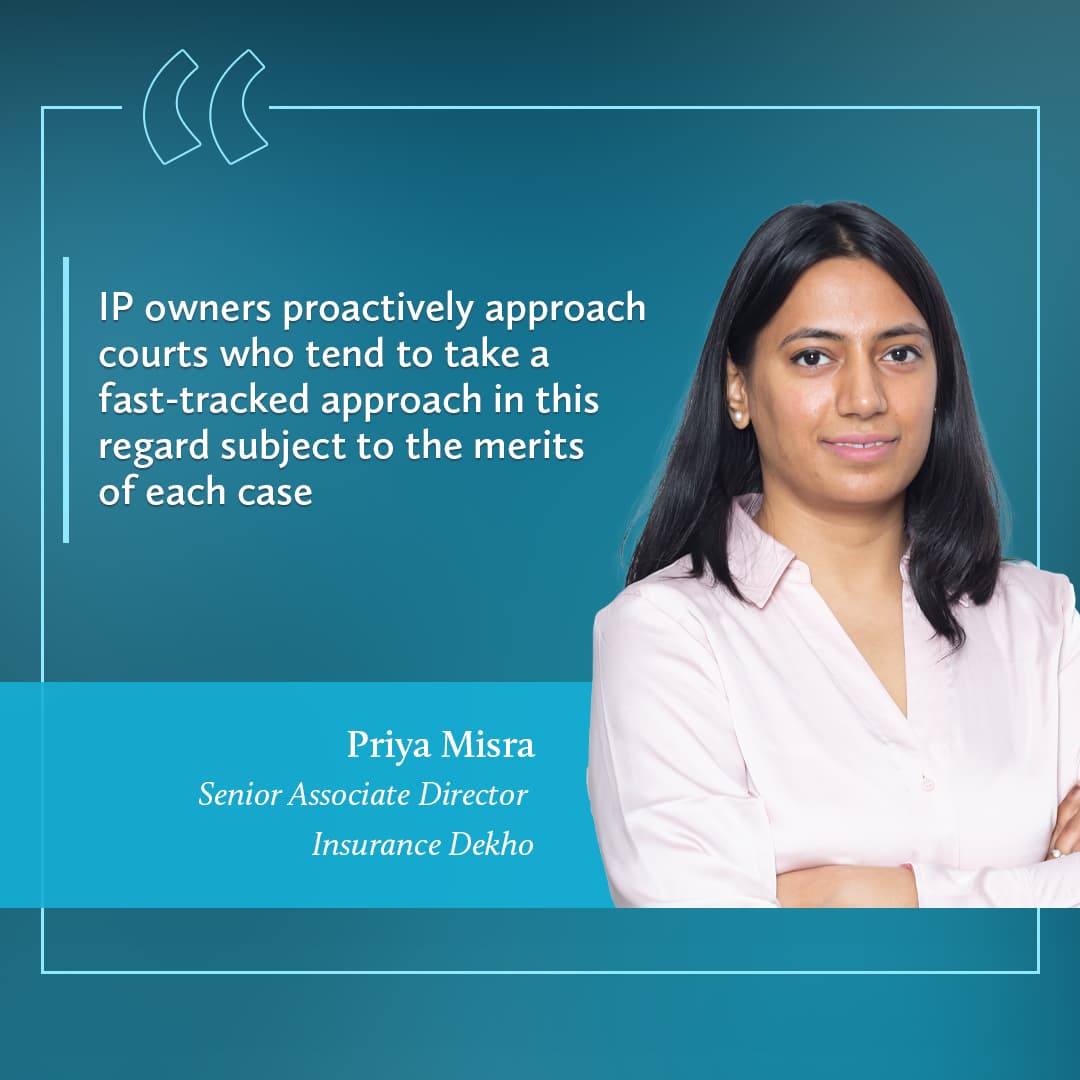Katherine Abraham investigates the planning and execution of IP search and seizure operations, and speaks to the lawyers who support clients on these raids
The rapid advancement of technology, coupled with an abundant talent pool and affordable resources, have turned India into an attractive market for businesses. While this has presented opportunities, it has also opened the door for unscrupulous individuals and businesses to exploit the goodwill of reputable organisations by producing counterfeit goods and services.
One of the reasons for the volume and size of the counterfeit market, according to Priya Misra, senior associate director at Insurance Dekho in New Delhi, is that “online marketplaces that operate in multiple countries [can] lead to jurisdictional complications, as it may get challenging for the proprietor to select the appropriate forum for challenging the IP infringement”.
Misra says another key reason for counterfeiters to escape unnoticed for extended periods of time is that counterfeiters “are present at various stages of sale such as sourcing raw material, manufacturing, transportation etc,” thus making it “commercially unviable to monitor and control every stage of production and distribution to inhibit all instances of counterfeiting”.
IP raids, more accurately known as search and seizure operations, are actions carried out by law enforcement agencies or other authorities to combat IP infringements. These operations typically investigate individuals or entities suspected of manufacturing, distributing or selling counterfeit goods, copyrighted material or pirated content on a mass scale, on the issuance of a court warrant.
IP-related search and seizure operations can be complex and often involve co-ordination between law enforcement agencies, IP rights holders and even international organisations. The element of surprise is key, but given the possibility of a transfer of counterfeit goods, there is no public announcement even after an IP raid, as that would denote a presumption of guilt.
The aim is not only to confiscate illegal goods but also to deter future infringement, and protect the rights of legitimate businesses and creators who stand to lose both reputation and profits.
IP raids vary in scale from small operations targeting local counterfeiters to operations co-ordinated across multiple jurisdictions to dismantle sophisticated piracy networks.
Section 63 of the Copyright Act, 1957, reads:
Offence of infringement of copyright or other rights conferred by this act. Any person who knowingly infringes or abets the infringement of:
- the copyright in a work, or
- any other right conferred by this act, except the right conferred by section 53A
shall be punishable with imprisonment for a term which shall not be less than six months but which may extend to three years and a fine, which shall not be less than INR50,000 but which may extend to INR200,000.
Sections 103, 104 and 105 of the Trade Marks Act, 1999, also stress the nature of infringements and the punishment for first time and repeat offenders.
But how well a raid will work in practice depends on solid advice and a lot of groundwork.
Procedural requirements
The IP raid is the outcome of a lengthy procedure and each stage has its own issues.
Essenesse Obhan, founder of Obhan & Associates in New Delhi, says: “Initiating an intellectual property raid in India involves several procedural requirements, and having the necessary documentation and evidence is crucial for the success and legality of the operation.”
Obhan says that one of the prerequisites is gathering sufficient evidence of an IP infringement, and adds the need to consider factors such as the “timing, location and logistics involved” in pre-raid plans, apart from ensuring that personnel involved in the raid “are adequately trained and briefed on their roles and responsibilities”.
For IP infringements, lawyers interviewed agree evidence may include but is not restricted to witness statements, the sale and purchase receipts of counterfeit goods, product samples, photographs, and any other digital or physical proof that can be used as relevant documentation to further establish the proposed infringement.
The aggrieved party can and is encouraged to carry out an initial private investigation to collect primary evidence of the infringement.
“Typically, when a court orders authorities to conduct a raid, the onus falls on the complainant company to pinpoint the location and even oversee the execution of such raids,” says K Satish Kumar, group legal officer at Intellect Design Arena, based in Chennai, adding: “the complainant company, in order to protect their IP, has to ensure that the process is carried out effectively.”
Vindhya Mani, a partner at Lakshmikumaran and Sridharan’s Bengaluru office, who has helped conduct raids, says: “The rights holder must disclose, to the best of their knowledge, all details and evidence that demonstrates a reasonable apprehension of infringing goods being located at the addresses submitted by them to the court.
“It is advisable that the rights holder engages a private investigation service to privately investigate the infringing activities and collect evidence for the court. This increases the chances of the court allowing the application for appointment of a local commissioner for the search and seizure activities.” Mani says this will maximise the rate of success in nabbing the offending parties involved.
Saif Khan, a partner and head of the white-collar crime practice and IP enforcement at Anand and Anand in Noida says: “Once the court is satisfied that the suit merits granting an ex parte injunction, a local commissioner may be appointed, who acts as a third party and as a representative of the court, and visits the premises of the defendants with the purpose of seizing and making an inventory of counterfeit products.
“An order of appointment of a local commissioner is akin to an Anton Piller Order under common law,” says Khan.
This leads law firms to the trickier aspects of the raid. “The main law enforcement agency that a law firm has to co-ordinate with for an IP raid is the local police, at the police station of the area where the site is situated,” says Utsav Mukherjee, founder attorney at the Office of Utsav Mukherjee in Gurugram.
Mukherjee says that IP raids in Delhi are conducted with ease because the police are familiar with them. Having helped conduct such raids, he adds: “Sites where infringing goods are stored are often warehouses at far flung locations, where addresses are not easy to find.
“One needs to be well aware of the exact location of the premises before travelling to the area. If the team carrying out the raid goes to the area and starts asking for the whereabouts of the premises, the infringer is likely to be alarmed and cover their tracks.”
Clearly, some operational raids do not all go as planned. Mukherjee recounts a time when he was part of a raid and there was no evidence found against the defendant until he went through their laptop and pulled out some incriminating records of invoices with the infringing trademark.
“I saved copies of the same in the pen drive that was to be submitted in court. Such evidence is crucial for a successful raid operation,” he says. Once the operations have culminated in a report by the local commissioner (also appointed by the court), it is the prerogative of the judiciary to weigh the value of the evidence presented.
Guilty or not guilty
Usually a defendant whose game is up tends to seek an out-of-court settlement, according to Mukherjee, who adds that these discussions “often take time and involve drawing up an agreement with terms that are agreeable to both parties”.
Misra, at Insurance Dekho, says Indian courts generally tend to take a proprietor-centric approach “and do not shy away from granting relief to IP owners to search an infringer’s premise and seize counterfeit products in order to ensure minimal monetary as well as reputational losses”.
Businesses spend a lot of time and money obtaining patents and trademarks. The expenses begin to mount from the moment they submit an application, and the cost for early publication of patents by companies is 500% higher than an individual’s application.
According to the official website of the Office of the Controller General of Patents, Designs and Trademarks (CGPDTM), generally known as the Indian Patent Office, the cost for filing a patent is INR8,000 (USD100) while for an individual it is INR1,600.
The examination process, too, can be expensive. The fee for fast-track examination varies based on the size of the entity. Large entities are required to pay INR60,000, while all other applicants incur a significantly lower fee of INR8,000.
For all these reasons, the courts are often quick to respond. “IP owners proactively approach courts who tend to take a fast-tracked approach in this regard subject to the merits of each case,” says Misra.
Criminal or civil?
The effectiveness of IP raids in deterring infringements depends on various factors, including the resources allocated.
These measures may also be a consequence of criminal actions instituted under appropriate provisions of the Trade Marks Act, 1999, and the Copyright Act, 1957, which leads to the question of how the aggrieved decide whether to pursue a criminal case or file a civil suit. Generally, the larger the aggrieved entity, the more likely it is to file a civil suit, especially given the costs. Smaller brands prefer to pursue criminal proceedings, which generally lead to imprisonment and costs.
“Search and seizure measures are a crucial anti-counterfeiting and IP-protection measure,” says Mani, at Lakshmikumaran. The final report submitted to the court, along with any evidence collected, after the conclusion of the local commission, is considered as part of the records of the court and treated as evidence.”
Civil suits generally involve initiating a lawsuit for trademark infringement, unfair competition or copyright violation in the commercial division of a high court, or the commercial court at the district level. These courts operate under the Commercial Courts Act, 2015, which expedites proceedings when compared to regular civil claims. Various applications may accompany the lawsuit, such as those for injunctions or the appointment of a local commissioner.
“The Commercial Courts Act has also made the timelines of a lawsuit shorter as neither party can delay the proceedings,” says Khan, at Anand and Anand. “[The act] is applicable to all courts in India and every state is required to have designated commercial divisions in their district courts or high court.”
Criminal actions involve filing a complaint with the appropriate law enforcement agency that specialises in IP, or the deputy commissioner of police. A normal process takes seven to 14 days in metropolitan areas and requires the presence of the complainant’s authorised representative during both the complaint filing and raid execution.
In criminal actions, the law enforcement agency first registers a case, conducts a raid, seizes counterfeit goods and may even arrest suspects. Subsequently, a charge sheet is filed, leading to trial, which could be expedited through plea bargaining.
“Criminal trials are lengthy and time consuming in comparison to civil actions, but the concept of plea bargaining under the Code of Criminal Procedure helps in expediting the entire case within a span of six to 12 months,” says Khan.
“In the event that an FIR [first information report] is not registered by the concerned official, the rights owner also has an option to file a complaint before the concerned magistrate, who is empowered to direct the concerned police official to take action,” he says.
An added issue lies in the fact that the report submitted post-execution of a local commission for search and seizure, while deemed evidence in infringement suits, lacks finality in determining merits.
Presentation of the evidence may feel like the raid and the outcome was successful, until the plaintiff/complainant realises the battle has been won, but not the war.
“The Supreme Court of India has held that these [local commission] reports are ‘non-adjudicatory’ in nature and the findings are open to challenge,” says Mani.
According to the Code of Civil Procedure, order XXVI rule 10, (3), where the court is for any reason dissatisfied with the proceedings of the commissioner, it may direct further inquiries to be made as it thinks fit.
A successful challenge could lead to the report being disregarded or, even worse, a fresh local commissioner could be appointed. These reports, however, have the ability to influence settlement negotiations, providing an independent account of the defendants’ activities, which further impacts the negotiation’s direction.
Assessing the impact
At the outset, the track record of courts disposing IP cases seems promising. Misra says that this is “evident from Delhi High Court, Intellectual Property Division’s (IPD) Annual Report 2022-2023, which states that, since February 2022, less than 1,000 cases were filed with the IPD within the first year of its inception, and 750-plus cases involving IPR disputes were disposed.”
To ensure effective raids lawyers advise companies to maintain confidentiality, ensure that details about the defendant are collected, conduct reconnaissance of the premises before the raid, co-ordinate raid teams, minimise disruption to legitimate business operations, prepare for unforeseen circumstances, and document the entire process through clear photographs and video recordings of on-the-spot proceedings, signed by the defendant or their representative.
IP raids can also attract the ire of the accused while the raid is being conducted. Khan says given that strong possibility, it is necessary to take pre-emptive measures. “To deal with such situations and avoid any mishap, civil raids must be conducted after taking necessary protection from local law enforcement.”
Mani adds: “It is always advisable that the entire execution of the local commissioner is recorded to tally the findings of the report with the events that transpired.”
Mukherjee advises that every “nook and cranny” down to the “bathrooms and toilets” must be checked because the evidence may be stashed literally anywhere.
Mani says rights holders must ensure that the report submitted “is accurate, precise and provides a holistic and detailed account of all the infringing activities, if any, that were observed”.
AMAZON, MICROSOFT JOINTLY FIGHT FRAUDSTERS
Anand and Anand assisted tech giants Amazon and Microsoft in addressing rampant global tech fraud issues. The firm initially analysed data and complaints, and established links between accused entities in India and abroad who were involved in these tech fraud schemes.
The effort culminated in the filing of criminal complaints and the registration of two FIRs with the Central Bureau of Investigation (CBI) against tech-support fraud scams. The perpetrators in this IP scam were masquerading as tech-support representatives, targeting foreign nationals in the US, Canada and Europe via call centres.
Dubbed “Operation Chakra-2”, the crackdown on cybercriminals involved close collaboration with the Ministry of Finance’s Financial Intelligence Unit, the US Federal Bureau of Investigation and Interpol.
The operation led to a 36-hour raid on 17 locations on 19 October 2023 in New Delhi, Uttar Pradesh, Haryana and Punjab, including nine call centres, residences and offices, which led to the dismantling of the complete cybercrime infrastructure of these gangs.
During the operation, CBI officials seized 32 mobile phones, 48 laptops and hard disks, and 33 SIM cards and pen drives. A large number of bank accounts were also frozen.
The team was led by partner Saif Khan and included partner Shantanu Sahay, senior associate Imon Roy and associate Prajjwal Kushwaha, who studied victim complaints and investigation reports to decipher the fraudsters’ modus operandi.
Liaising with law enforcement, they filed criminal complaints, safeguarding vulnerable individuals and reinforcing trust in digital platforms. The financial stakes were significant, with several victims defrauded of thousands of dollars, including one case involving a USD12 million cryptocurrency scam.
“Such frauds not only have dire financial implications for the victims but also jeopardise the reputation and trust that global brands like Amazon and Microsoft have dutifully built over the years,” says an Anand and Anand spokesperson.






























